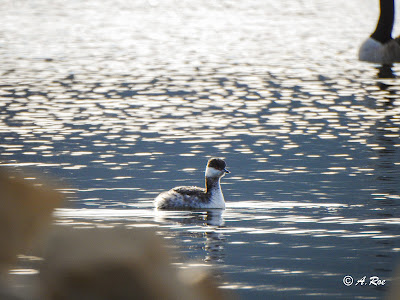Often I have people ask me why I enjoy birding so much. To that I ask back, how could you not? Birds are bright and colorful and sing some beautiful songs. Birds are able to construct complex nests without arms. Birds travel from long distances just for the opportunity to breed and continue the existence of their species. How could you not like birds?
While the person asking me the question then thinks of an answer and regrets asking me the initial question, I also tell them about all of the other great animals that I get to observe while out birding. So while it's about the birds, it's not all about the birds. Birding is about being outdoors, enjoying nature, and learning something new while doing it. In this week's post I want to share some of the photos, and maybe stories, of non-birds that I've captured while out birding. Let's get started!
 |
| Black Rat Snake (Pantherophis obsoletus) in a tree! |
I found this Black Rat Snake on one of those rare occasions where my wife agreed to go on a walk with me, knowing full well there was no way I wouldn't be birding at the same time. We were having a pretty good walk. I was teaching her some birds, she was pretending to be interested, we were having fun taking pictures of each other doing goofy poses. When we turned the corner to find this huge snake sitting right at eye level in a tree! My wife ran to the other side of the trail and I got as close as I felt both the snake and I were comfortable with. Of course I had to get pictures!
 |
| They're kind of cute. In a way only a mother (or nature nerd) could love. |
We were never expecting to find a snake on our walk, let alone in a tree. Now we always look up for snakes while in wooded areas.
 |
| Southern Leopard Frog (Rana sphenocephala) pretending not to see me. |
Frogs may be my second favorite animal group to photograph, behind birds of course. They have these amazingly beautiful, unblinking eyes and a zen manner that I wish I could tap into. I don't believe there is any special story behind this particular frog, I just really liked the photo.
 |
| Red-eared Sliders (Trachemys scripta elegans) sunbathing. |
Pond life in general can be some of the most interesting things you might see while out birding. While there are only three turtles in this photo, I have seen some logs with so many turtles on them that they stack on top of each other. The red patch on the side of the head of the middle turtle helps to identify these as Red-eared Sliders.
 |
| Familiar Bluets (Enallagma civile) having a bit of an intimate moment. |
We've made it to the insects! There are so many insects that you can see while out birding that it sometimes distracts from the birding. I love the color of these bluets. It's probably what drew my attention to them in the first place.
 |
| Gray Comma (Polygonia progne) on a Hackberry (Celtis occidentalis). |
Butterflies always catch my attention. They're so colorful and flit around so playfully that it's impossible not to watch them. If you've been birding on a hot day and your skin is sweaty, they may even land right on you.
 |
| Eastern Chipmunk (Tamias striatus) trying to convince me that it's not actually there. |
No animal has given me the hardest time in identification more than the Eastern Chipmunk. Not when I see them scurrying across the trail or into a hollowed out log. But when these little guys let out their warning calls they stump me every time. I stop and search for them for what seems like forever. The problem is, I'm always looking for a bird. The little chip noise that these tiny rodents make always catches me off-guard when I'm in birding mode. It almost sounds like a Northern Cardinal, but just slightly different.
 |
| Ohio Spiderwort (Tradescantia ohiensis) has to be one of the prettiest flowers that I find consistently. |
Flowers are the show stoppers. When I'm having trouble capturing images of the tiny flitting birds that I'm counting, it can be nice to slow down and photograph something that mostly sits still. And people always love seeing beautiful flower photos.
 |
| Asteraceae sp. |
I end this post with a beautiful Asteraceae species that I'm not 100% sure the identification of. This plant family hosts so many of the beautiful flowers that we often see that I have a hard time keeping track of them all. But through birding, I have become much more familiar with the plants around me and can identify many more than I ever used to. For me, birding makes me a better naturalist. It gets me out and looking at nature and curious about what I'm seeing around me. Birding has sparked such a deeper love and appreciation for nature in me that I have a hard time understanding why more people don't do it. It's a therapy for me and it's one thing that I love sharing with others.































.jpg)



